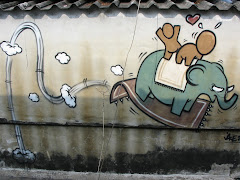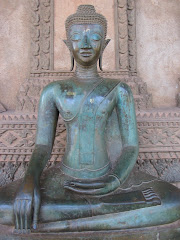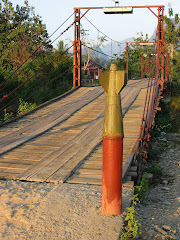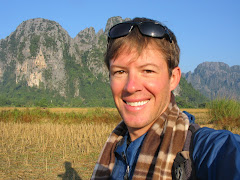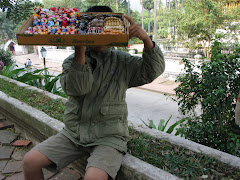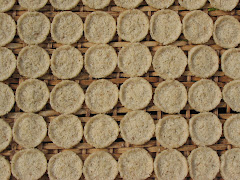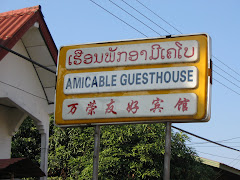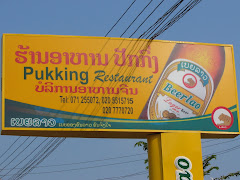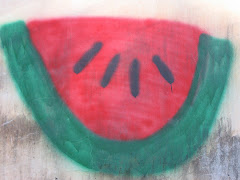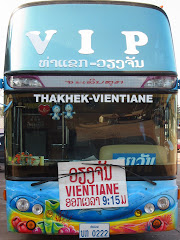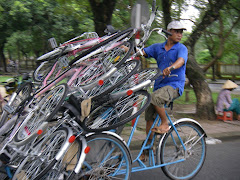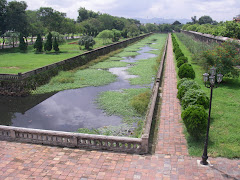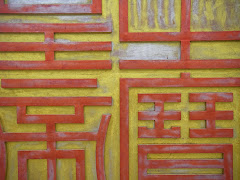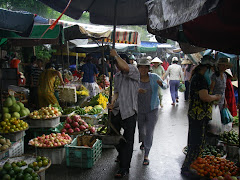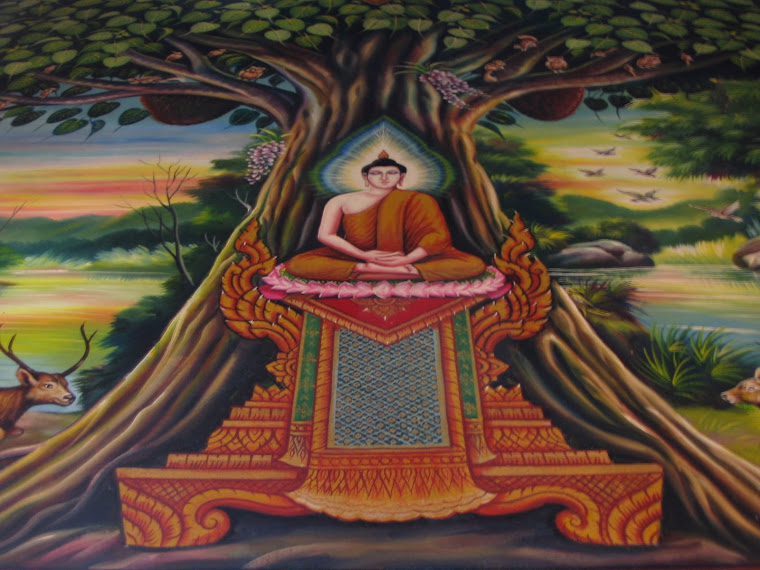 km between Pakse and the capital, Vientiane, in one go was about as appealing as having a jagged piece of bamboo poked up my rear. Conversely, I've found that I can't handle being in a local-style bus for more than about six hours before I start going nuts - due as much to the endless loops of sappy Thai music videos and Cambodian comedy shows played on the bus "entertainment centers" as to the painfully slow progress they make. By cutting the trip into a few sections, I hoped to regain bits and pieces of my soon to be tested patience. At any rate, travel during the day allowed me to see more of the central Lao countryside, although that turned out to be a bit anticlimactic - if you've seen a hundred stilt-houses, you've really seen them all.
km between Pakse and the capital, Vientiane, in one go was about as appealing as having a jagged piece of bamboo poked up my rear. Conversely, I've found that I can't handle being in a local-style bus for more than about six hours before I start going nuts - due as much to the endless loops of sappy Thai music videos and Cambodian comedy shows played on the bus "entertainment centers" as to the painfully slow progress they make. By cutting the trip into a few sections, I hoped to regain bits and pieces of my soon to be tested patience. At any rate, travel during the day allowed me to see more of the central Lao countryside, although that turned out to be a bit anticlimactic - if you've seen a hundred stilt-houses, you've really seen them all. Traveling complaints aside, both Savannakhet and Tha Kheak turned out to be pretty pleasant stops. Savannakhet, in particular, is sort of the classic backwater French Indochina administrative capital of old. Lots of decaying French-style buildings lining the riverfront neighborhood streets. The gentrification potential is huge, but alas, no one seems particularly attached to the colonial reminders. A shame from my point of view, but I guess you can't blame the locals for wanting something new and flashy as opposed to old and Frenchy. Anyway, I thoroughly enjoyed wandering the dusty streets and caught a couple spectacular riverside sunsets as I watched the sun sink into Thailand on the far side of the Mekong.
Pulling out of Tha Khaek for the final leg of the journey to Vientiane, I caught an early tuk tuk (taxi) out to the bus station and at the last minute waffled and then folded. Instead of taking my planned "regular" bus I decided to cough up an extra 20,000 kip ($2.50!) for the privilege of riding the two-story "VIP" bus. In addition to negating the necessity of sharing the aisles and (potentially) my seat with locals and\or livestock, the later departure provided a couple hours to mill about the bus station as it slowly came alive for another day - people watching at its best. As a half-awake shopkeep er kept my steaming coffee cup topped off I chatted and mimed with the chain smoking taxi drivers waiting for incoming fares. Perusing the sidewalk food vendors who were assembling I feigned disgust (ok, it was real disgust) at the racks of freshly killed squirrels for sale. Mmmm....furry breakfast, anyone? After a couple hours it was finally time to mount up and head out.
er kept my steaming coffee cup topped off I chatted and mimed with the chain smoking taxi drivers waiting for incoming fares. Perusing the sidewalk food vendors who were assembling I feigned disgust (ok, it was real disgust) at the racks of freshly killed squirrels for sale. Mmmm....furry breakfast, anyone? After a couple hours it was finally time to mount up and head out.
 er kept my steaming coffee cup topped off I chatted and mimed with the chain smoking taxi drivers waiting for incoming fares. Perusing the sidewalk food vendors who were assembling I feigned disgust (ok, it was real disgust) at the racks of freshly killed squirrels for sale. Mmmm....furry breakfast, anyone? After a couple hours it was finally time to mount up and head out.
er kept my steaming coffee cup topped off I chatted and mimed with the chain smoking taxi drivers waiting for incoming fares. Perusing the sidewalk food vendors who were assembling I feigned disgust (ok, it was real disgust) at the racks of freshly killed squirrels for sale. Mmmm....furry breakfast, anyone? After a couple hours it was finally time to mount up and head out.In the end, the VIP bus turned out to be a mixed blessing. It was certainly more comfortable than the regular buses - roomier, fewer Thai music videos, less stops - but being double tiered had the effect of amplifying the swaying back and forth that comes with cruising the Lao "highways." I suffered from a bit of motion sickness - didn't lose breakfast or anything, but it was heading in that direction. After five hours of rollercoasting (as opposed to the 9 hour ride the regular bus provides) we pulled into Vientiane. In the end, it took about three extra days, but was worth every frustrationless second.





































 ed over our passports and fees for processing. By the time the regular gaggle of food vendors had cleaned my pockets of soon to be worthless Dong, the passports had been signed, stamped, and returned. Good to go! Back on the boat for a few more hours before reaching the first town of any size, along with its paved road. Transfer to a waiting mini-van, and by 8:00pm we were rolling into Phnom Penh.
ed over our passports and fees for processing. By the time the regular gaggle of food vendors had cleaned my pockets of soon to be worthless Dong, the passports had been signed, stamped, and returned. Good to go! Back on the boat for a few more hours before reaching the first town of any size, along with its paved road. Transfer to a waiting mini-van, and by 8:00pm we were rolling into Phnom Penh.


